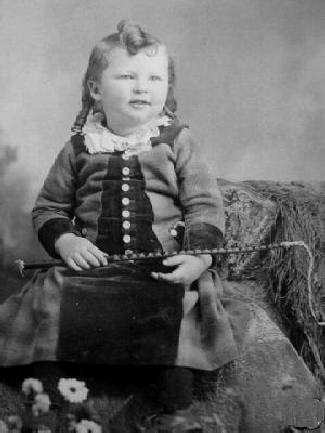
Whip Props in Advertising Illustrations: Significance

Figure 1.--This little boy was photographed in Montpelier, Vermont. It was undated, but looks to have been made in the 1880s. We think the whip here is probably a toy, but we are not positive. We believe that it was included in the portrait to make a statement that the child was a boy. We are unsure, however, who would have done this: the photographer, the mother, or the father.
|
We do not have any definitive statement on what this represented and how to interpret them. We think that they were probably props that emphasize that younger boys, often dressed in skirted garments, are definitely boys. We suspect that they were props that the photo studio had handy for their customers. They also seem to be toys. They look to be small, caled down models of actual buggy whips. The buggy whips the children are posed with seem to be toys. They look to be small, caled down models of actual buggy whips. I think they represented buggy whips associated with driving horses and carriages. Some seem small. Perhaps there were toy whips for children. Boys probably liked the idea of driving carriages like modern boys want to drive cars. A good example is an English boy with his hobby horse in the 1860s. Thus a whip probably strongly suggests a boy. We believe that riding crops have to be considered differently than buggy whips. Both boys and girls rode so the riding crop may not have had gender connotations.
Studio Props
We wonder if parents and if so which parent would have brought these whips to the portrait studios. This would suggest that the message they were designed to comvedy was very important. We suspect that these whips were props that the photo studio had handy for their customers. But we do not have any real evidence one way or the other. We have not yet noted this subject discussed in any period sources.
Buggy Whips
The buggy whips the children are posed with seem to be toys. They look to be small, caled down models of actual buggy whips. I think they represented buggy whips associated with driving horses and carriages. Some seem small. Perhaps there were toy whips for children. Boys probably liked the idea of driving carriages like modern boys want to drive cars. A good example is an English boy with his hobby horse in the 1860s. Thus a whip probably strongly suggests a boy. Now we have not given the same attemtion to old portraits of girls. Our initial impression, however, is that the children posed with buggy whips are mostly boys. We are unsure just how commonly they were actually used as children's toys. Boys being boys, if you give a boy a whip, he is likely to use it on animals and playmates. So we are unsure just how common they are. Given the number we have noted in portraits and magazines they may well have been popular toys. They certainly are illustrated as toys. A good example is a Harper's ad in 1878.
Riding Crops
We believe that riding crops have to be considered differently than buggy whips. Both boys and girls rode so the riding crop may not have had gender connotations.
Corporal Punishment
A Canadian reader writes, "Do you know why the kids are often keeping a whip in their hands? To play pony ? A sign of wealthy family? The fear to be beaten like it is told in La comtesse de Ségur's stories (Les malheurs de Sophie and Les petites filles modèles)?" `HBC thinks that while it is true that corporal punishment was much more common in the 19th century. I don't think that is what is illustrated in portraits. I think it was more that they were toys or added as props to emphasize that the child photographed was a boy.
HBC

Navigate the Boys' Historical Clothing Web Site:
[Return to:Main whip prop page]
[Return to:Main photo prop page]
[Introduction]
[Activities]
[Biographies]
[Chronology]
[Cloth and textiles]
[Clothing styles]
[Countries]
[Topics]
[Bibliographies]
[Contributions]
[FAQs]
[Glossaries]
[Images]
[Satellite sites]
[Tools]
[Boys' Clothing Home]
Navigate the Boys' Historical Clothing Web Site:
[Sailor suits]
[Sailor hats]
[Buster Brown suits]
[Eton suits]
[Rompers]
[Tunics]
[Smocks]
[Pinafores]
Created: 1:55 AM 11/28/2005
Last updated: 1:55 AM 11/28/2005



